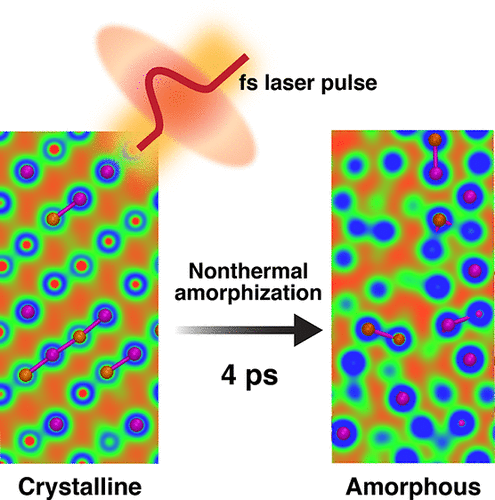当前位置:
X-MOL 学术
›
J. Phys. Chem. Lett.
›
论文详情
Our official English website, www.x-mol.net, welcomes your
feedback! (Note: you will need to create a separate account there.)
Photoexcitation Induced Ultrafast Nonthermal Amorphization in Sb2Te3
The Journal of Physical Chemistry Letters ( IF 4.8 ) Pub Date : 2020-11-19 , DOI: 10.1021/acs.jpclett.0c02521 Subodh C. Tiwari 1 , Rajiv K. Kalia 1 , Aiichiro Nakano 1 , Fuyuki Shimojo 2 , Priya Vashishta 1 , Paulo S. Branicio 1
The Journal of Physical Chemistry Letters ( IF 4.8 ) Pub Date : 2020-11-19 , DOI: 10.1021/acs.jpclett.0c02521 Subodh C. Tiwari 1 , Rajiv K. Kalia 1 , Aiichiro Nakano 1 , Fuyuki Shimojo 2 , Priya Vashishta 1 , Paulo S. Branicio 1
Affiliation

|
Phase-change materials are of great interest for low-power high-throughput storage devices in next-generation neuromorphic computing technologies. Their operation is based on the contrasting properties of their amorphous and crystalline phases, which can be switched on the nanosecond time scale. Among the archetypal phase change materials based on Ge–Sb–Te alloys, Sb2Te3 displays a fast and energy-efficient crystallization–amorphization cycle due to its growth-dominated crystallization and low melting point. This growth-dominated crystallization contrasts with the nucleation-dominated crystallization of Ge2Sb2Te5. Here, we show that the energy required for and the time associated with the amorphization process can be further reduced by using a photoexcitation-based nonthermal path. We employ nonadiabatic quantum molecular dynamics simulations to investigate the time evolution of Sb2Te3 with 2.6, 5.2, 7.5, 10.3, and 12.5% photoexcited valence electron–hole carriers. Results reveal that the degree of amorphization increases with excitation, saturating at 10.3% excitation. The rapid amorphization originates from an instantaneous charge transfer from Te-p orbitals to Sb-p orbitals upon photoexcitation. Subsequent evolution of the excited state, within the picosecond time scale, indicates an Sb–Te bonding to antibonding transition. Concurrently, Sb–Sb and Te–Te antibonding decreases, leading to formation of wrong bonds. For photoexcitation of 7.5% valence electrons or larger, the electronic changes destabilize the crystal structure, leading to large atomic diffusion and irreversible loss of long-range order. These results highlight an ultrafast energy-efficient amorphization pathway that could be used to enhance the performance of phase change material-based optoelectronic devices.
中文翻译:

光激发引起Sb 2 Te 3中超快非热非晶化
相变材料对于下一代神经形态计算技术中的低功耗高吞吐量存储设备非常感兴趣。它们的操作基于其非晶相和结晶相的对比特性,可以在纳秒级上切换。在基于Ge–Sb–Te合金的原型相变材料中,Sb 2 Te 3由于其以生长为主的结晶和低熔点而显示出快速而节能的结晶-非晶化循环。该生长为主的结晶与Ge 2 Sb 2 Te 5的成核为主的结晶形成对比。在这里,我们表明,通过使用基于光激发的非热路径,可以进一步减少非晶化过程所需的能量和与时间相关的时间。我们采用非绝热量子分子动力学模拟来研究Sb 2 Te 3与2.6、5.2、7.5、10.3和12.5%光激发价电子-空穴载流子的时间演化。结果表明,非晶化程度随激发而增加,在10.3%激发时达到饱和。快速非晶化源自从Te- p轨道到Sb- p的瞬时电荷转移光激发后的轨道。在皮秒级的时间内,激发态的后续演化表明Sb-Te键向反键跃迁。同时,Sb-Sb和Te-Te的反键降低,导致形成错误的键。对于7.5%价电子或更高价电子的光激发,电子变化会破坏晶体结构的稳定性,从而导致大的原子扩散和不可逆的远距离有序损失。这些结果突出了可用于增强相变材料基光电器件性能的超快速节能非晶化途径。
更新日期:2020-12-03
中文翻译:

光激发引起Sb 2 Te 3中超快非热非晶化
相变材料对于下一代神经形态计算技术中的低功耗高吞吐量存储设备非常感兴趣。它们的操作基于其非晶相和结晶相的对比特性,可以在纳秒级上切换。在基于Ge–Sb–Te合金的原型相变材料中,Sb 2 Te 3由于其以生长为主的结晶和低熔点而显示出快速而节能的结晶-非晶化循环。该生长为主的结晶与Ge 2 Sb 2 Te 5的成核为主的结晶形成对比。在这里,我们表明,通过使用基于光激发的非热路径,可以进一步减少非晶化过程所需的能量和与时间相关的时间。我们采用非绝热量子分子动力学模拟来研究Sb 2 Te 3与2.6、5.2、7.5、10.3和12.5%光激发价电子-空穴载流子的时间演化。结果表明,非晶化程度随激发而增加,在10.3%激发时达到饱和。快速非晶化源自从Te- p轨道到Sb- p的瞬时电荷转移光激发后的轨道。在皮秒级的时间内,激发态的后续演化表明Sb-Te键向反键跃迁。同时,Sb-Sb和Te-Te的反键降低,导致形成错误的键。对于7.5%价电子或更高价电子的光激发,电子变化会破坏晶体结构的稳定性,从而导致大的原子扩散和不可逆的远距离有序损失。这些结果突出了可用于增强相变材料基光电器件性能的超快速节能非晶化途径。











































 京公网安备 11010802027423号
京公网安备 11010802027423号